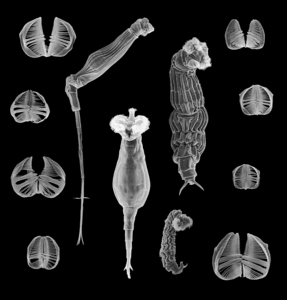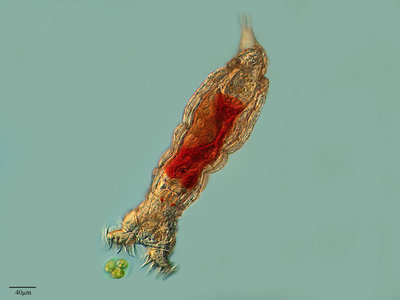Bdelloidea
- Habrotrochidae
- Habrotrocha
- Otostephanos
- Scepanotrocha
- Philodinavidae
- Abrochtha
- Henoceros
- Philodinavus
- Philodinidae
- Anomopus
- Ceratotrocha
- Didymodactylus
- Dissotrocha
- Embata
- Macrotrachela
- Mniobia
- Philodina
- Pleuretra
- Rotaria
- Zelinkiella
- Adinetidae
- Adineta
- Bradyscela
References
Birky Jr., C. W. 2004. Bdelloid rotifers revisited. Proceedings of the National Academy of Sciences (USA) 101:2651–2652.
Donner, J. 1965. Ordnung Bdelloidea. Akademie-Verlag, Berlin. 297 pp.
Fontaneto, D., E. A. Herniou, T. G. Barraclough, C. Ricci, and G. Melone. 2007. On the reality and recognisability of asexual organisms: morphological analysis of the masticatory apparatus of bdelloid rotifers. Zoologica Scripta 36(4):361–370.
Hur, J. H., K. Van Doninck, M. L. Mandigo, and M. Meselson. 2009. Degenerate tetraploidy was established before bdelloid rotifer families diverged. Molecular Biology and Evolution 26(2):375-383; doi:10.1093/molbev/msn260
Judson, O. P. and B. B. Normark. 2000. Sinless originals. Science 288:1185-1186.
Mark Welch, D. B. and M. Meselson. 2000. Evidence for the evolution of bdelloid rotifers without sexual reproduction or genetic exchange. Science 288:1211–1215.
Mark Welch, D. B., J. L. Mark Welch, and M. Meselson. 2004. Cytogenetic evidence for asexual evolution of bdelloid rotifers. Proceedings of the National Academy of Sciences (USA) 101(6):1618-1621.
Melone, G. and C. Ricci. 1995. Rotatory apparatus in bdelloids. Hydrobiologia 313/314:91–98.
Melone, G., C. Ricci, H. Segers and R.L. Wallace. 1998. Phylogenetic relationships of phylum Rotifera with emphasis on the families of Bdelloidea, Hydrobiologia 387/388:101–107.
Melone, G., C. Ricci, and H. Segers. 1998. The trophi of Bdelloidea (Rotifera): a comparative study across the class. Canadian Journal of Zoology 76:1755–1765.
Ricci, C. 1987. Ecology of bdelloids: how to be successful, Hydrobiologia 147:117–127.
Ricci, C. 1998. Anhydrobiotic capabilities of bdelloid rotifers. Hydrobiologia 387/388:321–326.
Ricci, C. 1998. Are lemnisci and proboscis present in the Bdelloidea?, Hydrobiologia 387/388:93–96.
Ricci, C. and G. Melone. 2000. Key to the identification of the genera of bdelloid rotifers. Hydrobiologia 418:73–80.
Segers, H. 2002. The nomenclature of the Rotifera: annotated checklist of valid family- and genus-group names. Journal of Natural History 36:631-640.
Information on the Internet
- Eighty million years without sex. BBC News
- Bdelloids: No sex for over 40 million years. Science News
- The Weird Sisters. The Wild Side, Olivia Judson.
Title Illustrations

| Scientific Name | Bdelloidea |
|---|---|
| Comments | Morphological variation of bdelloid rotifers and their jaws |
| Reference | Gross L (2007) Who Needs Sex (or Males) Anyway? PLoS Biol 5(4): e99 doi:10.1371/journal.pbio.0050099 |
| Specimen Condition | Dead Specimen |
| Body Part | jaws |
| Source | Who Needs Sex (or Males) Anyway? |
| Source Collection | Public Library of Science (PLoS) |
| Image Use |
 This media file is licensed under the Creative Commons Attribution License - Version 2.5. This media file is licensed under the Creative Commons Attribution License - Version 2.5.
|
| Copyright | © 2007 Diego Fontaneto |
| Scientific Name | Philodina roseola |
|---|---|
| Location | Lardero, La Rioja, Spain |
| Comments | Es fácil encontrarlo en charcos pequeños o en lagunas y, si el agua se evapora, él, después de deshidratarse, puede volver a la vida como si nada...una y otra vez, siempre y cada vez que se secan los charcos en los que habita, Philodina pierde todo el agua de sus tejidos, se seca y cuando el agua vuelve, también él vuelve a la vida. Pero además, por si fuera poco, es uno de los organismos más resistentes a los rayos gamma que se conocen. Cualquier otro ser vivo quedaría abrasado y su material genético descompuesto ante una exposición a la radiación gamma. Sin embargo, Philodina roseola es capaz de restaurar los daños en el ADN que en otras especies serían irreversibles. Y, aún más...otra particularidad que le acerca casi a la inmortalidad y que está relacionada con su reproducción: es un organismo que se reproduce sexualmente sin necesidad del otro sexo. Los óvulos sin fecundar dan lugar a nuevos individuos, siempre hembras (partenogénesis). Pues aquí tenemos a nuestro superhéroe, discreto y casi desconocido, haciendo malabarismos con un grupito de algas en espera de que su charca se vuelva a secar. La muestra en la que se ha tomado la fotografía fue recolectada hace dos días junto al embalse de La Grajera, en Logroño. La foto se ha realizado a 200 aumentos empleando la técnica de contraste de interferencia. También en www.iesbatalladeclavijo.com/tablon/webvidaoculta/index.html y en www.fotolog.com/proyectoagua. ...junto con nuestro granito de arena por la paz en http://www.fund-culturadepaz.org/spa/03/cent03Articulos%202003/En_pie_de_paz.pdf |
| Source | PHILODINA ROSEOLA, EL ROTÍFERO INMORTAL |
| Source Collection | Flickr |
| Image Use |
 This media file is licensed under the Creative Commons Attribution-NonCommercial-NoDerivs License - Version 2.0. This media file is licensed under the Creative Commons Attribution-NonCommercial-NoDerivs License - Version 2.0.
|
| Copyright | © 2009 ANTONIO GUILLÉN |
About This Page
Page copyright © 2006
 Page: Tree of Life
Bdelloidea.
The TEXT of this page is licensed under the
Creative Commons Attribution-NonCommercial License - Version 3.0. Note that images and other media
featured on this page are each governed by their own license, and they may or may not be available
for reuse. Click on an image or a media link to access the media data window, which provides the
relevant licensing information. For the general terms and conditions of ToL material reuse and
redistribution, please see the Tree of Life Copyright
Policies.
Page: Tree of Life
Bdelloidea.
The TEXT of this page is licensed under the
Creative Commons Attribution-NonCommercial License - Version 3.0. Note that images and other media
featured on this page are each governed by their own license, and they may or may not be available
for reuse. Click on an image or a media link to access the media data window, which provides the
relevant licensing information. For the general terms and conditions of ToL material reuse and
redistribution, please see the Tree of Life Copyright
Policies.
- First online 27 July 2006
- Content changed 27 July 2006
Citing this page:
Tree of Life Web Project. 2006. Bdelloidea. Version 27 July 2006 (temporary). http://tolweb.org/Bdelloidea/20454/2006.07.27 in The Tree of Life Web Project, http://tolweb.org/










 Go to quick links
Go to quick search
Go to navigation for this section of the ToL site
Go to detailed links for the ToL site
Go to quick links
Go to quick search
Go to navigation for this section of the ToL site
Go to detailed links for the ToL site